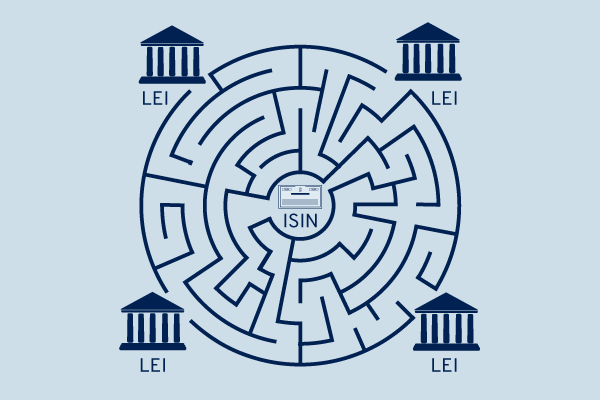To provide an LEI lookup and better match the entities with the instruments traded, in April 2019, the Global Legal Entity Identifier Foundation (GLEIF) and the Association of National Numbering Agencies (ANNA) began issuing a daily open-source relationship file linking LEIs with International Securities Identification Numbers (ISINs). This free, frequently updated data increases the transparency of risk exposures, making it easier for firms to accurately determine their exposure in their securities holdings.
Using LEI lookup to address challenges
A common challenge for financial services firms is that a legal entity is often represented differently in multiple systems, including trading systems. This causes confusion, duplication and errors, for example, sending the wrong entity identifier to a central counterparty (CCP) or in a regulatory submission, e.g. MiFID II.
Having the LEI-ISIN links coming from the originators of those identifiers, GLEIF and ANNA respectively, makes the daily relationship file, also known as a ‘matching file’, the mechanism of choice to mitigate previously common problems with transaction and entity data. An LEI lookup and an ISIN lookup had been missing in the industry. Third-party feeds had been the only information available, with logic based on their proprietary entity hierarchies. The matching file does not replace those feeds, but augments them and therefore enhances their overall accuracy and effectiveness.
The matching file can help catch issues that occur when a security used in a transaction lacks either a LEI or an ISIN, or if the LEI belongs to a related entity such as a parent company or a subsidiary different than the entity that actually participated in the trade. Some data managers may have once been inclined to say that mistakes like these would never happen, because they are using a leading third-party data provider’s proprietary identifier. However, many applications and reporting proxies require the LEI to match and verify entities, so this third-party data on its own is not enough. A dependable LEI lookup is required. The matching file can confirm LEI and ISIN data coming from those data providers, or augment those providers’ feeds when they are missing LEIs.
Conversely, the matching file helps firms see all the instruments that are under a given LEI. So, with the matching file, one can find the issuer of an instrument or all the instruments from a given issuer.
The matching file as a resource
The matching file is also a resource that a service provider like GoldenSource can build upon, using the file to pre-seed a robust security master/entity master structure. Such a structure can then be further enriched by whichever security and entity data products the end user firm deems best in terms of the depth of their instrument and entity data.
Going well beyond an LEI lookup, consolidating entity data from numerous master files, as a gold copy in a central system, enables all systems and users to draw from a common, validated source. Furthermore, central management of ancillary data such as standard settlement instructions (SSIs), International Swaps and derivatives Association (ISDA) netting sets, and account and sub account hierarchies, ensures that limits and risk exposures can be managed effectively and a single view of an entity’s relationship across all business lines can be assessed.
For more information on making the most of the ISIN-to-LEI Relationship Files, contact us here


